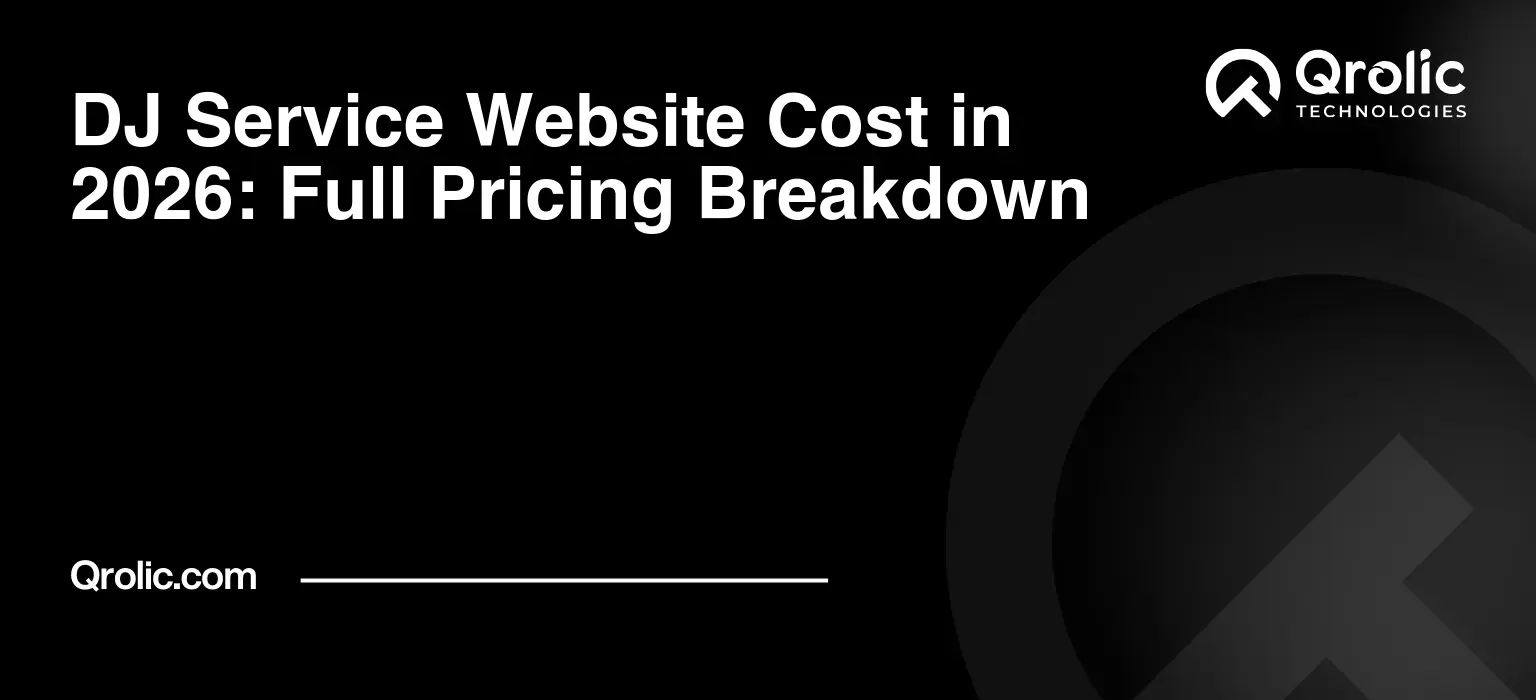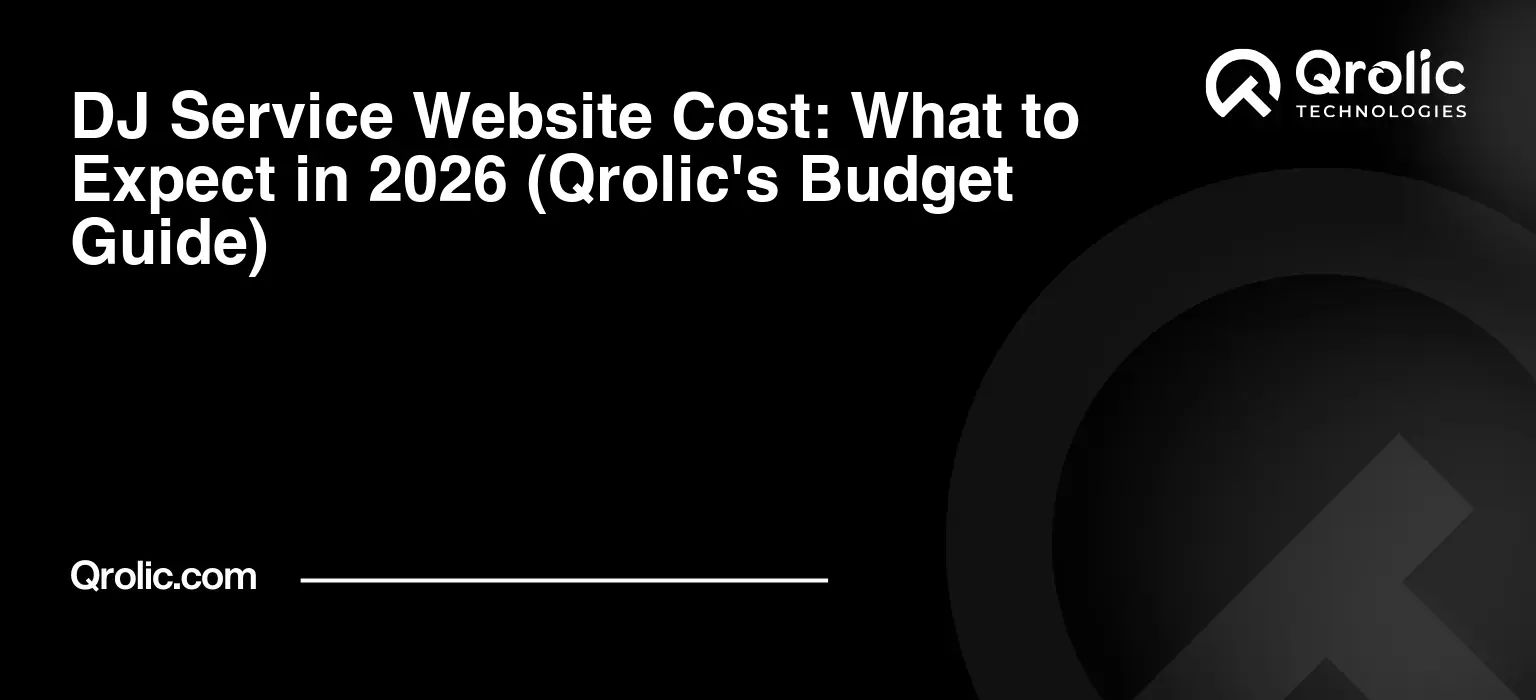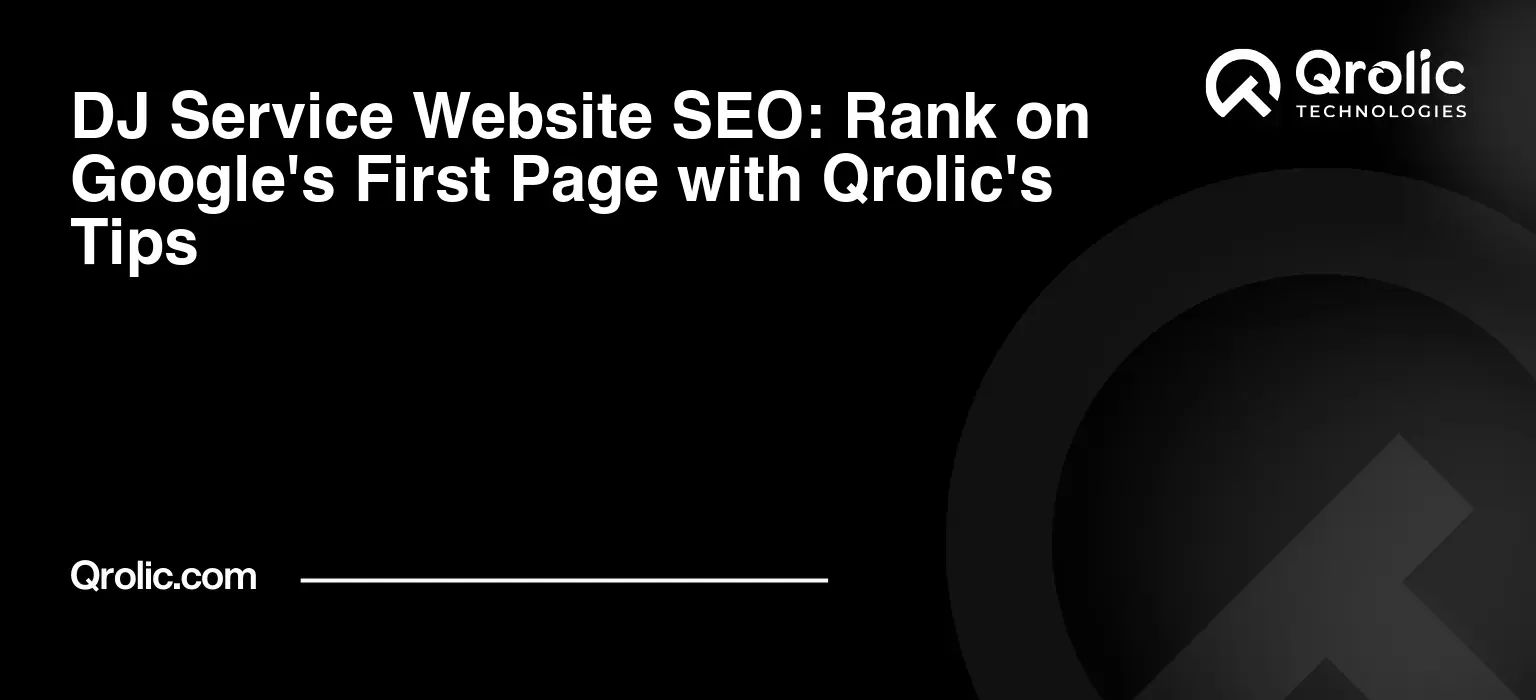Quick Summary:
- Design your website with stunning visuals and mobile-friendliness.
- Clearly showcase services, music, and your availability.
- Use easy booking forms to streamline client inquiries.
- Optimize your site for search engines to attract new clients.
Table of Contents
- Creating a Website That Amplifies Your DJ Brand
- I. The Foundation: Essential Website Design Elements
- 1. Visually Stunning Design: Capturing the Vibe
- 2. Compelling Content: Telling Your Story
- 3. Strong Call to Actions (CTAs): Guiding User Behavior
- II. Supercharging User Experience (UX)
- 1. Intuitive Navigation: Making it Easy to Explore
- 2. Fast Loading Speed: Keeping Visitors Engaged
- 3. Accessibility: Reaching a Wider Audience
- III. The Power of the Event Calendar
- 1. Showcasing Your Availability: Transparency is Key
- 2. Building Excitement: Creating Anticipation
- 3. Driving Bookings: Converting Interest into Action
- IV. Streamlining the Booking Process with Effective Booking Forms
- 1. Gathering Essential Information: Knowing Your Clients
- 2. Creating a User-Friendly Experience: Simplicity is Key
- 3. Automating the Booking Workflow: Saving Time and Resources
- V. SEO Optimization: Getting Found Online
- 1. Keyword Research: Understanding Your Audience’s Needs
- 2. On-Page Optimization: Making Your Website Search Engine Friendly
- 3. Off-Page Optimization: Building Your Website’s Authority
- VI. Additional Features That Can Give You An Edge
- VII. Why Choose Qrolic Technologies to Build Your DJ Website?
- Conclusion: Your Website, Your Stage
Creating a Website That Amplifies Your DJ Brand
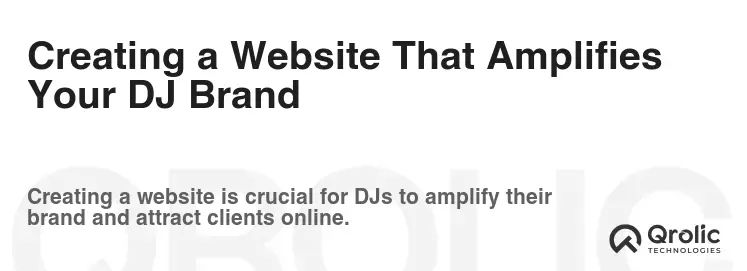
A captivating online presence is no longer optional; it’s the rhythm driving your DJ service’s success. Your website serves as your digital storefront, your 24/7 ambassador, and the ultimate tool for attracting clients, showcasing your talent, and securing bookings. Forget generic templates! Your website needs to resonate with your target audience, exude professionalism, and make booking your services as easy as tapping a beat.
This guide dives deep into the key features that will transform your DJ service website from a static page into a client-attracting powerhouse. We’ll explore everything from essential design elements and user experience (UX) considerations to crucial SEO strategies and booking functionalities. Get ready to amplify your online presence and watch your bookings soar!
I. The Foundation: Essential Website Design Elements
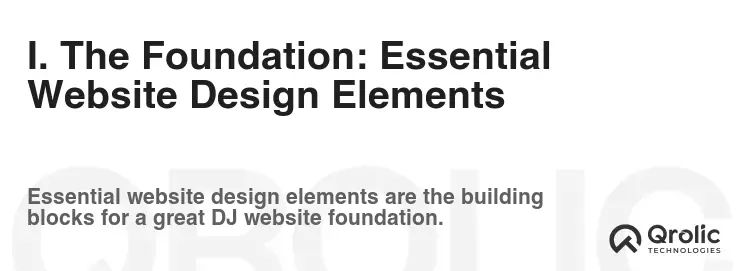
Before we dive into the specific features, let’s lay the groundwork with the core design elements that every successful DJ service website needs.
1. Visually Stunning Design: Capturing the Vibe
- Why It Matters: Your website is the first impression many potential clients will have of your DJ service. A visually appealing design instantly communicates your professionalism and sets the tone for the experience you offer.
- Key Elements:
- High-Quality Images and Videos: Showcase your talent in action. Invest in professional photos and videos of your DJ sets, events you’ve played, and your overall brand aesthetic. Use images of happy crowds, dynamic lighting, and you behind the decks, creating an energetic and inviting atmosphere.
- Brand-Consistent Color Palette and Typography: Choose colors and fonts that reflect your DJ style and target audience. If you specialize in elegant wedding receptions, opt for sophisticated and classic design elements. If you’re a high-energy club DJ, bolder colors and fonts might be more appropriate.
- Mobile-Responsive Design: In today’s mobile-first world, your website must be responsive, meaning it adapts seamlessly to any device (desktops, tablets, smartphones). A clunky or non-functional mobile experience will drive potential clients away instantly. Use Google’s mobile-friendly test to ensure optimal viewing.
- Clean and Intuitive Navigation: Make it easy for visitors to find what they’re looking for. Use clear and concise navigation menus and avoid clutter. The goal is to guide users effortlessly through your website.
2. Compelling Content: Telling Your Story
- Why It Matters: Your website’s content is your opportunity to connect with potential clients on a deeper level, showcase your expertise, and build trust.
- Key Elements:
- About Me/Us Page: This is your chance to introduce yourself, share your DJing journey, and highlight your experience and qualifications. Let your personality shine through! Include testimonials and client feedback to build credibility. Showcase your passion for music and your dedication to creating unforgettable experiences.
- Services Offered: Clearly outline the different types of DJ services you offer (weddings, corporate events, private parties, clubs, etc.). Provide detailed descriptions of each service, including what’s included (e.g., sound system, lighting, MC services). Consider packages for different budget levels.
- Music Library/Genre Expertise: Highlight the genres of music you specialize in. This helps potential clients determine if your musical style aligns with their event’s needs. You can even include short audio clips or playlists to showcase your mixing skills and musical taste.
- Blog (Optional but Recommended): A blog can be a powerful tool for attracting new clients and establishing yourself as an authority in the DJ industry. Write about topics relevant to your target audience, such as wedding planning tips, event music trends, or DJing advice. This can also greatly improve your search engine ranking.
3. Strong Call to Actions (CTAs): Guiding User Behavior
- Why It Matters: CTAs are essential for converting website visitors into leads and bookings. They prompt users to take specific actions, such as contacting you for a quote or booking your services.
- Key Elements:
- Prominent Placement: Place CTAs strategically throughout your website, particularly on your homepage, services pages, and contact page.
- Compelling Wording: Use action-oriented language that encourages users to click. Examples include “Book Now,” “Get a Free Quote,” “Contact Us Today,” and “Check Availability.”
- Visual Appeal: Make your CTAs stand out visually with contrasting colors and button designs.
- Clear Value Proposition: Clearly communicate the benefit of clicking the CTA. For example, “Get a Free Quote and Let’s Make Your Event Unforgettable.”
II. Supercharging User Experience (UX)
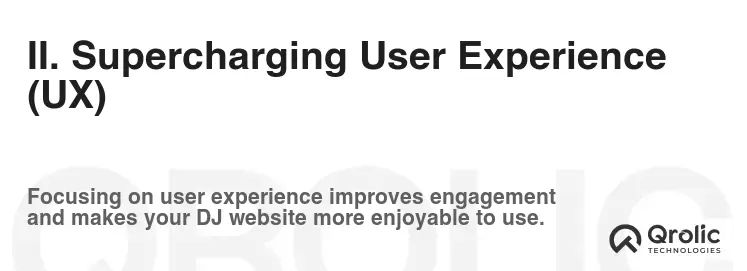
A visually appealing website is only half the battle. A seamless and enjoyable user experience (UX) is crucial for keeping visitors engaged and converting them into clients.
1. Intuitive Navigation: Making it Easy to Explore
- Why It Matters: If visitors can’t easily find what they’re looking for, they’ll quickly abandon your website.
- Key Elements:
- Clear and Concise Menu Structure: Organize your website’s content into logical categories. Use a simple and intuitive menu structure that is easy to understand.
- Search Functionality: Include a search bar to allow users to quickly find specific information.
- Breadcrumbs: Use breadcrumbs to show users their location within the website and make it easy to navigate back to previous pages.
- Mobile-Friendly Navigation: Ensure that your navigation menu is easily accessible and usable on mobile devices.
2. Fast Loading Speed: Keeping Visitors Engaged
- Why It Matters: Slow loading speeds can frustrate visitors and negatively impact your website’s search engine ranking.
- Key Elements:
- Optimize Images: Compress images to reduce file size without sacrificing quality.
- Leverage Browser Caching: Enable browser caching to store website data on users’ computers, allowing for faster loading times on subsequent visits.
- Minimize HTTP Requests: Reduce the number of HTTP requests by combining CSS and JavaScript files.
- Choose a Reliable Hosting Provider: Select a hosting provider with fast servers and a good track record of uptime.
- Content Delivery Network (CDN): Use a CDN to distribute your website’s content across multiple servers, ensuring fast loading times for users around the world.
3. Accessibility: Reaching a Wider Audience
- Why It Matters: Making your website accessible to people with disabilities is not only the right thing to do, but it also expands your potential audience.
- Key Elements:
- Alternative Text for Images: Provide descriptive alternative text for all images, allowing screen readers to describe the images to visually impaired users.
- Keyboard Navigation: Ensure that your website can be navigated using only a keyboard.
- Sufficient Color Contrast: Use sufficient color contrast between text and background to make your website easier to read for people with visual impairments.
- Clear and Concise Language: Use clear and concise language that is easy to understand.
- WAI-ARIA Attributes: Use WAI-ARIA attributes to provide additional information to assistive technologies.
III. The Power of the Event Calendar
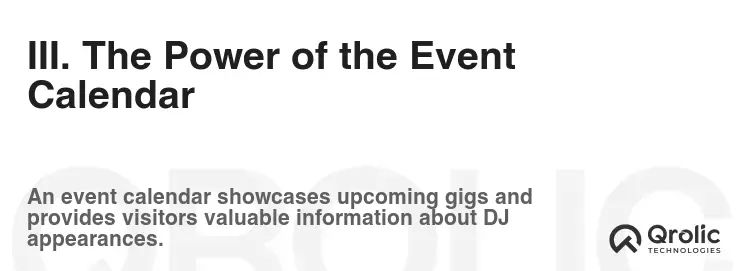
Your event calendar is more than just a list of dates; it’s a powerful marketing tool that can drive bookings, build excitement, and showcase your expertise.
1. Showcasing Your Availability: Transparency is Key
- Why It Matters: An event calendar allows potential clients to quickly see your availability and determine if you’re the right fit for their event. Transparency builds trust and streamlines the booking process.
- Key Elements:
- Clear and Concise Display: Use a visually appealing calendar layout that is easy to read and understand.
- Filtering Options: Allow users to filter events by type (weddings, corporate events, clubs, etc.) or location.
- Detailed Event Information: Provide detailed information about each event, including the date, time, location, and type of event. You can even include photos or videos from previous events.
- Real-Time Updates: Ensure that your calendar is always up-to-date with your latest availability.
- Integration with Booking System: Integrate your event calendar with your booking system to allow users to book your services directly from the calendar.
2. Building Excitement: Creating Anticipation
- Why It Matters: A well-designed event calendar can generate excitement and anticipation for your upcoming events.
- Key Elements:
- Highlight Upcoming Events: Feature upcoming events prominently on your homepage and social media channels.
- Share Event Details on Social Media: Use your event calendar to automatically share event details on social media.
- Create Teaser Content: Create teaser content, such as photos and videos from previous events, to build anticipation for upcoming events.
- Offer Exclusive Discounts: Offer exclusive discounts to users who book your services through the event calendar.
- Run Contests and Giveaways: Run contests and giveaways to generate buzz and attract new followers.
3. Driving Bookings: Converting Interest into Action
- Why It Matters: The ultimate goal of your event calendar is to drive bookings and generate revenue.
- Key Elements:
- Direct Booking Links: Include direct booking links on each event listing.
- Clear Call to Actions: Use clear and compelling calls to action to encourage users to book your services.
- Offer Special Packages: Offer special packages that are only available through the event calendar.
- Provide Incentives to Book Early: Provide incentives to book your services early, such as discounts or free upgrades.
- Follow Up with Potential Clients: Follow up with potential clients who have expressed interest in booking your services.
IV. Streamlining the Booking Process with Effective Booking Forms
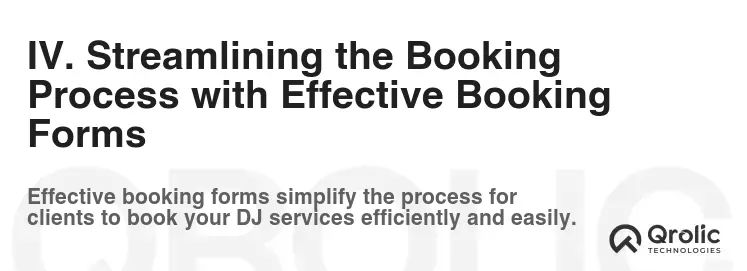
Say goodbye to endless email chains and confusing phone calls! Implementing well-designed booking forms is crucial for streamlining your booking process and providing a professional and efficient experience for your clients.
1. Gathering Essential Information: Knowing Your Clients
- Why It Matters: Booking forms allow you to collect all the necessary information about your client’s event in a structured and organized manner. This helps you prepare effectively and deliver a personalized experience.
- Key Elements:
- Client Contact Information: Collect the client’s name, email address, phone number, and address.
- Event Details: Gather information about the event date, time, location, type of event, and expected number of guests.
- Music Preferences: Ask about the client’s music preferences, including desired genres, specific songs, and any “do-not-play” lists.
- Technical Requirements: Inquire about any specific technical requirements, such as power outlets, sound system needs, and lighting preferences.
- Additional Services: Offer options for additional services, such as MC services, uplighting, and photo booth rentals.
- Budget: Ask about the client’s budget to help you tailor your services to their needs.
2. Creating a User-Friendly Experience: Simplicity is Key
- Why It Matters: A user-friendly booking form encourages clients to complete the booking process without frustration. A clunky or confusing form can lead to abandoned bookings.
- Key Elements:
- Clear and Concise Language: Use clear and concise language that is easy to understand.
- Logical Flow: Organize the form in a logical order, guiding users through the booking process step-by-step.
- Progress Indicators: Use progress indicators to show users how far they are in the form.
- Mobile-Responsive Design: Ensure that the form is fully responsive and easily usable on mobile devices.
- Error Validation: Implement error validation to prevent users from submitting the form with incomplete or incorrect information.
3. Automating the Booking Workflow: Saving Time and Resources
- Why It Matters: Booking forms can be integrated with your CRM and other business tools to automate your booking workflow and save you time and resources.
- Key Elements:
- Integration with CRM: Integrate your booking form with your CRM to automatically create new client profiles and track booking information.
- Automated Email Notifications: Set up automated email notifications to confirm bookings, send reminders, and provide updates to clients.
- Payment Integration: Integrate your booking form with a payment gateway to allow clients to pay for your services online.
- Calendar Integration: Integrate your booking form with your calendar to automatically schedule events.
- Reporting and Analytics: Use reporting and analytics tools to track booking trends and identify areas for improvement.
V. SEO Optimization: Getting Found Online
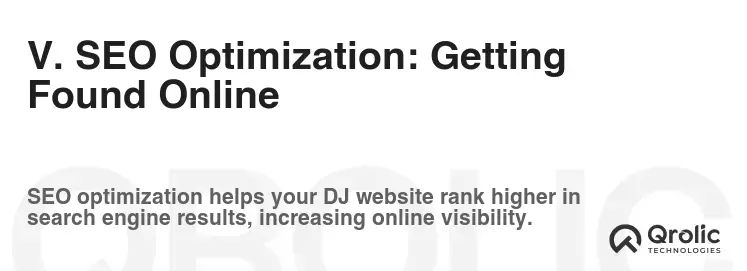
Having a fantastic website is useless if no one can find it. Search Engine Optimization (SEO) is the key to driving organic traffic to your website and attracting new clients.
1. Keyword Research: Understanding Your Audience’s Needs
- Why It Matters: Keyword research helps you identify the terms that potential clients are using to search for DJ services online.
- Key Elements:
- Identify Relevant Keywords: Use keyword research tools (e.g., Google Keyword Planner, Ahrefs, SEMrush) to identify relevant keywords related to your DJ services, location, and target audience. Examples include “wedding DJ [city],” “corporate event DJ [city],” “DJ for hire [city],” and “[genre] DJ [city].”
- Analyze Keyword Competition: Analyze the competition for each keyword to identify opportunities for ranking.
- Target Long-Tail Keywords: Target long-tail keywords (longer, more specific phrases) to attract highly qualified leads. For example, “affordable wedding DJ in downtown [city]” or “90s music DJ for corporate event.”
- Local Keywords: Focus on local keywords to target potential clients in your service area.
2. On-Page Optimization: Making Your Website Search Engine Friendly
- Why It Matters: On-page optimization involves optimizing your website’s content and structure to improve its search engine ranking.
- Key Elements:
- Optimize Title Tags and Meta Descriptions: Use relevant keywords in your title tags and meta descriptions to improve click-through rates from search engine results pages (SERPs).
- Use Header Tags (H1-H6): Use header tags to structure your content and highlight important keywords.
- Optimize Images: Use descriptive file names and alt text for all images.
- Create High-Quality Content: Create high-quality, informative, and engaging content that is relevant to your target audience and includes relevant keywords.
- Internal Linking: Use internal links to connect different pages on your website and improve navigation.
- Mobile-Friendliness: Ensure that your website is mobile-friendly and responsive.
- Website Speed: Optimize your website’s loading speed to improve user experience and search engine ranking.
3. Off-Page Optimization: Building Your Website’s Authority
- Why It Matters: Off-page optimization involves building your website’s authority and reputation through external sources.
- Key Elements:
- Link Building: Acquire high-quality backlinks from reputable websites in your industry. This can be done through guest blogging, directory submissions, and outreach to other website owners.
- Social Media Marketing: Promote your website and content on social media to increase brand awareness and drive traffic.
- Online Directory Listings: List your business in online directories, such as Yelp, Google My Business, and local business directories.
- Online Reviews: Encourage clients to leave positive reviews on your website and online directories.
- Brand Mentions: Monitor online mentions of your brand and respond to comments and questions.
VI. Additional Features That Can Give You An Edge
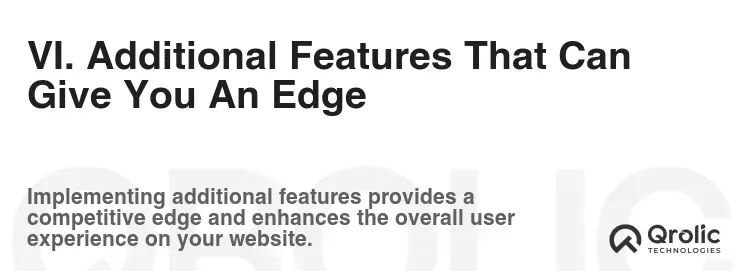
While the features mentioned above are essential, incorporating these additional elements can further elevate your website and provide a competitive advantage:
- Client Testimonials: Prominently display client testimonials on your homepage and services pages to build trust and credibility.
- Photo and Video Galleries: Showcase your past events with high-quality photo and video galleries.
- Blog: Regularly publish blog posts on topics relevant to your target audience to attract new visitors and establish yourself as an expert.
- FAQ Section: Answer frequently asked questions to address common concerns and save time on individual inquiries.
- Live Chat: Provide real-time support to website visitors through a live chat feature.
- Integration with Music Streaming Services: Allow visitors to listen to your mixes and playlists directly on your website.
- Multi-Language Support: If you serve a diverse clientele, consider adding multi-language support to your website.
- Secure Socket Layer (SSL) Certificate: An SSL certificate encrypts data transmitted between your website and visitors, ensuring secure communication. Displaying a security badge can further improve trust.
VII. Why Choose Qrolic Technologies to Build Your DJ Website?
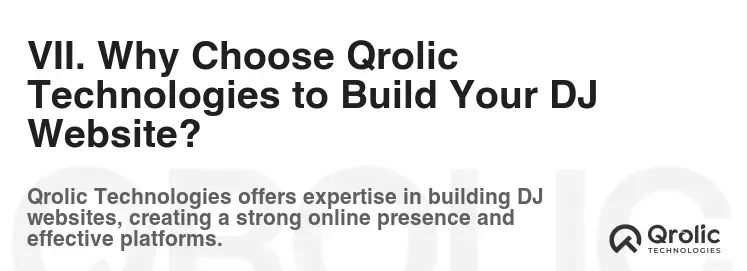
In today’s digital landscape, your website is the cornerstone of your DJ service’s success. Qrolic Technologies (https://qrolic.com/) understands this implicitly. We’re not just website developers; we’re partners in amplifying your brand and maximizing your online potential.
Here’s why partnering with Qrolic Technologies is the perfect beat for your DJ service:
- Expertise in the Music Industry: We have extensive experience working with clients in the music industry, understanding the specific needs and challenges of DJs and performers. We speak your language and know what resonates with your target audience.
- Custom Website Design: We don’t believe in cookie-cutter solutions. We’ll work closely with you to create a custom website design that reflects your unique brand identity and showcases your talent.
- User-Centric Approach: We prioritize user experience (UX) to ensure that your website is easy to navigate, visually appealing, and engaging for visitors.
- SEO Optimization: We’re experts in SEO and will optimize your website to rank high in search engine results, driving organic traffic and attracting new clients.
- Mobile-First Development: We ensure that your website is fully responsive and optimized for mobile devices, providing a seamless experience for users on any device.
- Integrated Booking Solutions: We’ll integrate your website with a powerful booking system to streamline the booking process and make it easy for clients to book your services.
- Ongoing Support and Maintenance: We provide ongoing support and maintenance to ensure that your website is always up-to-date and running smoothly.
- Proven Track Record: We have a proven track record of delivering high-quality websites that generate results for our clients. Check out our portfolio to see some of our recent projects.
- Affordable Pricing: We offer competitive pricing packages to fit your budget.
Ready to Take Your DJ Service to the Next Level?
Contact Qrolic Technologies today to schedule a free consultation and learn how we can help you create a website that amplifies your brand, attracts new clients, and drives bookings. Visit us at https://qrolic.com/ and let’s turn up the volume on your online success!
Conclusion: Your Website, Your Stage
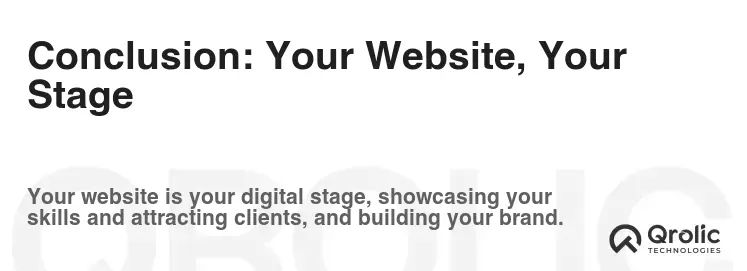
Your website is more than just a digital brochure; it’s your virtual stage, your 24/7 brand ambassador, and the key to unlocking new opportunities for your DJ service. By implementing the features outlined in this guide, you can create a website that not only looks great but also delivers results, attracting new clients, streamlining your booking process, and amplifying your brand’s reach. Don’t settle for mediocrity. Invest in a website that truly represents your talent and sets you apart from the competition. The beat goes on, and your website should be leading the rhythm!

